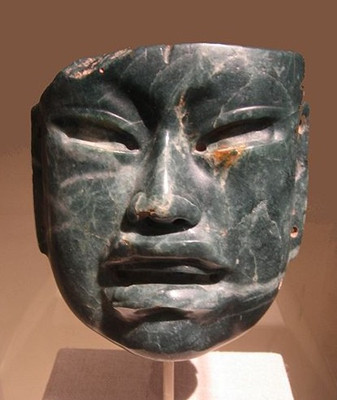I find this desire to discover European or Asian elements in ancient American societies fascinating.
我猜,如果你想在我們這副面具上找到非洲人或中國人的面孔特征,你一定能說服自己。
I think it's because the similarities between the cultures of the old and the new worlds are so strong-both produced pyramids and mummification, temples and priestly rituals, social structures and buildings that function in similar ways-that scholars found it hard to believe that these American cultures could have evolved like this in isolation.
但事實上,它體現的是十足的中美洲人的特點。這樣的面孔在今天生活在墨西哥的奧爾梅克人后裔身上還能看到。不過,想在古老的美洲社會找到歐洲或亞洲因素,找到古代社會相互關聯與影響的證據,也是歷史學家的迫切愿望,并極具啟發性。新大陸與舊的文明十分相似,都修建金字塔、制作木乃伊,廟宇、祭祀儀式、社會結構和建筑也都有類似之處。很長時間以來,學者都難以相信美洲是完全孤立地發展起來的。
But they did.
但事實就是如此。
At only five inches high, the mask is obviously far too small to have been worn over anybody's face, and it's much more likely that you'd have worn this round your neck or in a headdress, possibly for some kind of ceremony.
面具的高度只有十三厘米,很明顯無法戴在任何人臉上。它極有可能是戴在脖子上,或加在頭飾上、在某種儀式上佩戴的。
Small holes have been bored at the edges and at the top of the mask, so that you could easily fasten it with a bit of twine or thread.
面具的邊緣和頂部都有小孔,用細繩可以很方便地系上。
On either cheek you can see what, to my European eyes, look like two candles standing on a holder. To the eyes of the great Olmec specialist, Karl Taube, they're more likely to be the cardinal points of the compass, and they suggest that this person may have been a king:
臉頰兩邊刻有圖案,以我為歐洲人的眼光來看,那仿佛是燭臺上的兩支蠟燭。而在奧爾梅克專家卡爾陶布教授的眼里,那四條直線很可能代表了羅盤的基本方位。而他認為這可能是國王的肖像:
"For the Olmec we have these great colossal heads, we have thrones, portraits of kings and very often, important here too, is the concept of centrality.
我們見過許多巨大的頭像、國王的寶座和肖像,人們通常有一種中央觀念,會把國王放在世界的中心。
And so, on this finely carved serpentine mask, we see four elements on the cheek which are probably the four directions.
因此在這一精心雕琢的紋石面具上,我們看到的四個元素很可能代表了四個基本方位。
And so for the Olmec, of major concern were the world directions and world centre, with the king being the pivotal world axis in the world centre."
奧爾梅克人最關心的,便是以國王為世界中心和主軸的世界方位與世界核心。












